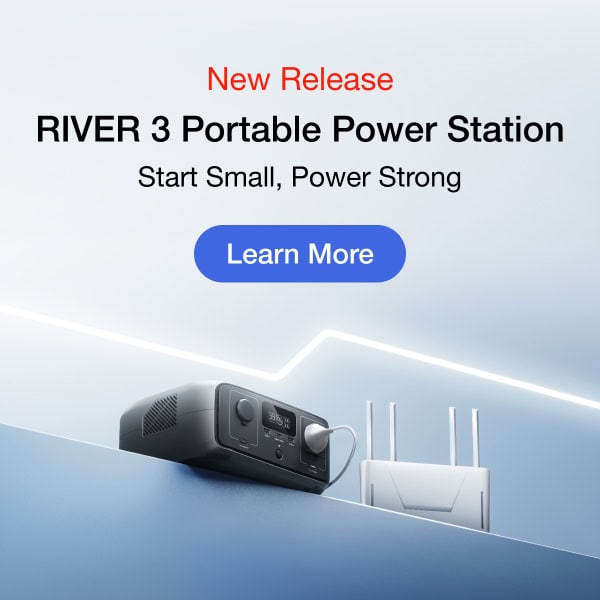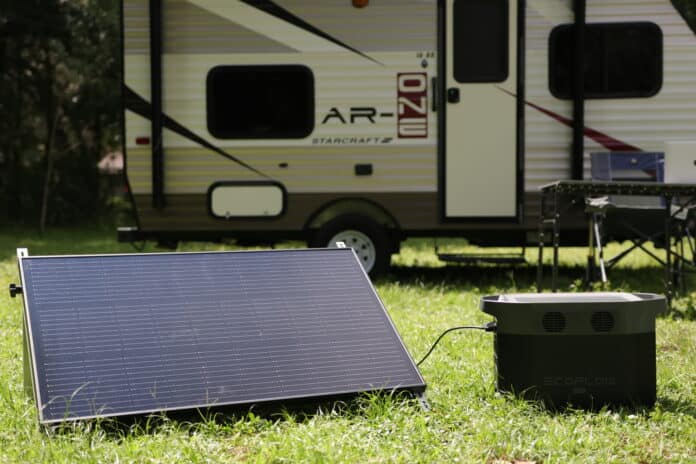Whether camping off-grid in your motorhome or enjoying the open seas on your boat, you probably can’t do without a 12V battery. Heading off-grid for any substantial period while still having enough electricity to run your essential devices means you’ll need a backup power source to recharge your motorhome, van, or boat battery.
In the past, you would need access to shore power to recharge your 12V battery. Now you can stay off-grid and recharge your battery with solar panels.
However, recharging a 12V battery with photovoltaic (PV) panels is more complicated than simply connecting the two. You’ll need all the right components and the know-how to optimise your solar panels for faster charging.
This guide will show you how to use solar panels to keep your 12V battery charged — no matter how long you’re off-grid or offshore.
What Size Solar Panel Do You Need to Charge a 12V Battery?
There are many different sizes and rated power outputs of PV solar panels, most of which are compatible with a 12V battery. The right size for you primarily depends on whether your panels match the battery’s amp hours, wattage, and voltage requirements, in addition to your energy consumption.
12V batteries come in various capacities from 5 to 200 amp-hours. Ask yourself the following questions before deciding which is the right size panel to charge your 12V battery:
- What’s the battery capacity in amp-hour (Ah) rating?
- How fast do you need the battery charged?
Let’s say you own a 12V battery with a 100 Ah capacity. Also, imagine you’re comfortable with a ten-hour charge time.
You’ll first need to convert the battery’s amp hours to determine the total wattage needed. The equation is as follows:
Amp-hours (Ah) x Volts (V) = Watts (Wh)
Keeping with the example above, the formula would look like this:
100Ah x 12 V = 1200 Wh
If you need your battery to recharge fully in 10 hours, you can calculate the following:
Total wattage (Wh) / recharge time in peak sun hours (h) = watts for panel
Plug in the numbers above, and you get:
1200Wh / 10 h = 120 watts
So, at a minimum, you’ll need a 120-watt rated panel to charge your 12V battery within ten hours.
Keep in mind that various other factors determine the panel’s recharge efficiency. For one, the greater the rated power of the solar panel, the faster you can charge your battery. For example, an EcoFlow 400W Rigid Solar Panel with a high conversion efficiency rating of 23% can recharge a 12V battery much faster than a traditional 100W panel.
Battery chemistry is also a significant factor. A lithium-ion battery is more efficient than a lead-acid one but requires higher panel wattage. All other factors being equal, you’d need a 120-watt solar panel for lead acid vs a 190-watt panel for a lithium battery.
The downside is that lead-acid batteries are less durable and have shorter lifespans. If your vehicle or boat is more than a decade old, chances are it uses a lead-acid battery — and you might want to consider an upgrade to a lithium-ion or LFP battery.
If you’re building your solar power system piece-by-piece, the charge controller you use to connect the solar panel to the battery also can make the charging process more or less efficient.
The two main types of charge controllers are Pulse Width Modulation (PWM) and Maximum Power Point Tracking (MPPT), with MPPT being considerably more efficient. If you have a lithium-ion battery and ten peak sun hours, you’d need a 160-watt solar panel with an MPPT charge controller vs a 190-watt panel with a PWM.
If you’re purchasing an all-in-one solar power system solution like EcoFlow’s DELTA series, all the necessary components are already included. You don’t have to worry about compatibility issues between components. Just connect the solar panels and plug and play.
How Many Solar Panels Do You Need to Charge a 12V Battery?
The number of solar panels needed depends on the rated power output of the panel itself. A standard EcoFlow 100W Flexible Solar Panel is enough to charge the most common 12V batteries and is easily affixed to a curved surface without requiring drilling.
If you want to recharge faster or require significant energy output, buy multiple solar panels to build a solar array. It’s also worth considering a modular power kit that can provide you with enough off-grid electricity to run anything you might need.
Components You Need to Charge a 12V Battery
Charging a 12V battery isn’t as simple as connecting the solar panels to the terminals. Directly charging a 12V battery with photovoltaic panels isn’t possible.
You’ll need the appropriate tools and components to connect the solar panels:
- 12V battery
- Solar panel(s)
- Solar charge controller (must be compatible with 12V batteries; PWM or MPPT)
- Battery cables
- Charge controller adapter cables
The charge controller regulates the electricity flow from the solar panels to the battery, protecting it from overcharging, which leads to permanent damage and can even be hazardous. Once the battery reaches full charge, the controller cuts off the DC energy supply, protecting it from potential harm.
In most cases, you’ll also want a solar power system with a solar battery to store excess power and an inverter to run devices and appliances that run on AC (household electricity).
How to Charge a 12V Battery with Solar Panels
Here’s a step-by-step guide on connecting your solar panels to charge a 12V battery:
Step 1: Connect the 12V Battery to Your Charge Controller
Check whether the 12V battery has wires. If not, you’ll need to purchase 10- or 16- gauge wires to connect them to the charge controller. Attach the stripped end of the positive battery wire to the position terminal and vice versa. Insert the bare wire ends into the charge controller ports and tighten them with a screwdriver.
Link the ring terminal of the positive battery wire to the positive terminal. Repeat the process for the negative battery cable.
Step 2: Connect Your Solar Panels to the Charge Controller
Attach the negative solar panel adapter cable to the negative solar panel cable. Do the same thing for the positive panel cable.
Plug the positive solar input cable into the positive solar PV terminal on the controller and tighten the terminal shut. Repeat this process for the negative input solar cable.
If you’re connecting multiple panels, which you can do with some systems like the EcoFlow Portable Solar Panels, you’ll need to use the Universal Solar Connectors to connect the panels in series.

Step 3: Check the Connection
Once the wires are connected, test the connection by turning on the battery and power system. The charge controller should turn on, indicating that the charge controller and battery are connected. Monitor your charge controller’s display screen and ensure it’s producing readings. If you see a zero or blank screen, you probably didn’t connect everything properly.
Checking the connection is even easier if you’re connecting your solar panels to a power station that you then use to charge the 12V battery. Portable power stations like the EcoFlow DELTA 2 have intelligent algorithms built into the MPPT to track the voltage and current rate in real time. With the dedicated EcoFlow app, you can monitor the voltage output and control the power station directly from your mobile device using an internet or BlueTooth connection. The built-in charge controller will keep you updated about the recharge time.
Step 4: Position the Solar Panels Under Direct Sunlight
Lastly, you’ll want to set up your solar panels with optimal orientation for the best light exposure. You can either mount rigid solar panels on your vehicle or boat’s roof. If you have a portable solar panel, use the kickstand to position it on the ground or deck.
Conclusion
The solar panel size you need to keep a 12V battery charged largely depends on your specific batteries wattage, voltage, amp-hours — and, of course, your energy consumption. Once you know the specifics, setting up a functioning solar power system between your solar panel and 12V battery is simple, especially if you use a portable power station or solar generator with everything built in.
Now that you’ve read this guide, you should have a rock-solid system that can deliver off-grid power anytime and anywhere there’s sunlight. Whether you’re a homeowner, motorhome owner, or outdoor enthusiast looking for recreational power, a solar energy system can give you incredible freedom.
Shop EcoFlow today to discover all your options for energy independence.





